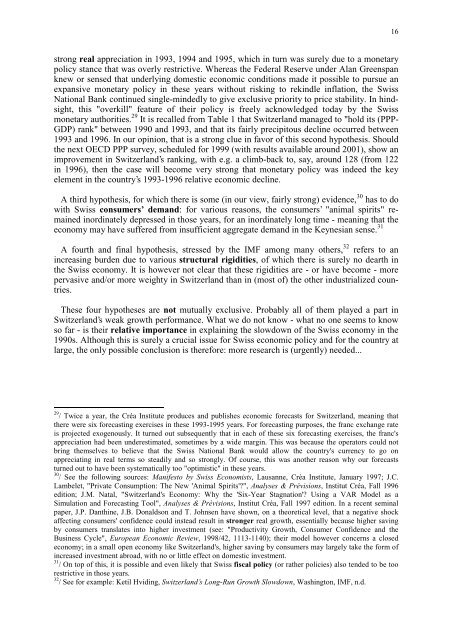Did the Swiss Economy Really Stagnate in the 1990s, and Is ...
Did the Swiss Economy Really Stagnate in the 1990s, and Is ...
Did the Swiss Economy Really Stagnate in the 1990s, and Is ...
Create successful ePaper yourself
Turn your PDF publications into a flip-book with our unique Google optimized e-Paper software.
16<br />
strong real appreciation <strong>in</strong> 1993, 1994 <strong>and</strong> 1995, which <strong>in</strong> turn was surely due to a monetary<br />
policy stance that was overly restrictive. Whereas <strong>the</strong> Federal Reserve under Alan Greenspan<br />
knew or sensed that underly<strong>in</strong>g domestic economic conditions made it possible to pursue an<br />
expansive monetary policy <strong>in</strong> <strong>the</strong>se years without risk<strong>in</strong>g to rek<strong>in</strong>dle <strong>in</strong>flation, <strong>the</strong> <strong>Swiss</strong><br />
National Bank cont<strong>in</strong>ued s<strong>in</strong>gle-m<strong>in</strong>dedly to give exclusive priority to price stability. In h<strong>in</strong>dsight,<br />
this "overkill" feature of <strong>the</strong>ir policy is freely acknowledged today by <strong>the</strong> <strong>Swiss</strong><br />
monetary authorities. 29 It is recalled from Table 1 that Switzerl<strong>and</strong> managed to "hold its (PPP-<br />
GDP) rank" between 1990 <strong>and</strong> 1993, <strong>and</strong> that its fairly precipitous decl<strong>in</strong>e occurred between<br />
1993 <strong>and</strong> 1996. In our op<strong>in</strong>ion, that is a strong clue <strong>in</strong> favor of this second hypo<strong>the</strong>sis. Should<br />
<strong>the</strong> next OECD PPP survey, scheduled for 1999 (with results available around 2001), show an<br />
improvement <strong>in</strong> Switzerl<strong>and</strong>’s rank<strong>in</strong>g, with e.g. a climb-back to, say, around 128 (from 122<br />
<strong>in</strong> 1996), <strong>the</strong>n <strong>the</strong> case will become very strong that monetary policy was <strong>in</strong>deed <strong>the</strong> key<br />
element <strong>in</strong> <strong>the</strong> country’s 1993-1996 relative economic decl<strong>in</strong>e.<br />
A third hypo<strong>the</strong>sis, for which <strong>the</strong>re is some (<strong>in</strong> our view, fairly strong) evidence, 30 has to do<br />
with <strong>Swiss</strong> consumers’ dem<strong>and</strong>: for various reasons, <strong>the</strong> consumers’ "animal spirits" rema<strong>in</strong>ed<br />
<strong>in</strong>ord<strong>in</strong>ately depressed <strong>in</strong> those years, for an <strong>in</strong>ord<strong>in</strong>ately long time - mean<strong>in</strong>g that <strong>the</strong><br />
economy may have suffered from <strong>in</strong>sufficient aggregate dem<strong>and</strong> <strong>in</strong> <strong>the</strong> Keynesian sense. 31<br />
A fourth <strong>and</strong> f<strong>in</strong>al hypo<strong>the</strong>sis, stressed by <strong>the</strong> IMF among many o<strong>the</strong>rs, 32 refers to an<br />
<strong>in</strong>creas<strong>in</strong>g burden due to various structural rigidities, of which <strong>the</strong>re is surely no dearth <strong>in</strong><br />
<strong>the</strong> <strong>Swiss</strong> economy. It is however not clear that <strong>the</strong>se rigidities are - or have become - more<br />
pervasive <strong>and</strong>/or more weighty <strong>in</strong> Switzerl<strong>and</strong> than <strong>in</strong> (most of) <strong>the</strong> o<strong>the</strong>r <strong>in</strong>dustrialized countries.<br />
These four hypo<strong>the</strong>ses are not mutually exclusive. Probably all of <strong>the</strong>m played a part <strong>in</strong><br />
Switzerl<strong>and</strong>’s weak growth performance. What we do not know - what no one seems to know<br />
so far - is <strong>the</strong>ir relative importance <strong>in</strong> expla<strong>in</strong><strong>in</strong>g <strong>the</strong> slowdown of <strong>the</strong> <strong>Swiss</strong> economy <strong>in</strong> <strong>the</strong><br />
<strong>1990s</strong>. Although this is surely a crucial issue for <strong>Swiss</strong> economic policy <strong>and</strong> for <strong>the</strong> country at<br />
large, <strong>the</strong> only possible conclusion is <strong>the</strong>refore: more research is (urgently) needed...<br />
29 / Twice a year, <strong>the</strong> Créa Institute produces <strong>and</strong> publishes economic forecasts for Switzerl<strong>and</strong>, mean<strong>in</strong>g that<br />
<strong>the</strong>re were six forecast<strong>in</strong>g exercises <strong>in</strong> <strong>the</strong>se 1993-1995 years. For forecast<strong>in</strong>g purposes, <strong>the</strong> franc exchange rate<br />
is projected exogenously. It turned out subsequently that <strong>in</strong> each of <strong>the</strong>se six forecast<strong>in</strong>g exercises, <strong>the</strong> franc's<br />
appreciation had been underestimated, sometimes by a wide marg<strong>in</strong>. This was because <strong>the</strong> operators could not<br />
br<strong>in</strong>g <strong>the</strong>mselves to believe that <strong>the</strong> <strong>Swiss</strong> National Bank would allow <strong>the</strong> country's currency to go on<br />
appreciat<strong>in</strong>g <strong>in</strong> real terms so steadily <strong>and</strong> so strongly. Of course, this was ano<strong>the</strong>r reason why our forecasts<br />
turned out to have been systematically too "optimistic" <strong>in</strong> <strong>the</strong>se years.<br />
30 / See <strong>the</strong> follow<strong>in</strong>g sources: Manifesto by <strong>Swiss</strong> Economists, Lausanne, Créa Institute, January 1997; J.C.<br />
Lambelet, "Private Consumption: The New 'Animal Spirits'?", Analyses & Prévisions, Institut Créa, Fall 1996<br />
edition; J.M. Natal, "Switzerl<strong>and</strong>'s <strong>Economy</strong>: Why <strong>the</strong> 'Six-Year Stagnation'? Us<strong>in</strong>g a VAR Model as a<br />
Simulation <strong>and</strong> Forecast<strong>in</strong>g Tool", Analyses & Prévisions, Institut Créa, Fall 1997 edition. In a recent sem<strong>in</strong>al<br />
paper, J.P. Danth<strong>in</strong>e, J.B. Donaldson <strong>and</strong> T. Johnsen have shown, on a <strong>the</strong>oretical level, that a negative shock<br />
affect<strong>in</strong>g consumers' confidence could <strong>in</strong>stead result <strong>in</strong> stronger real growth, essentially because higher sav<strong>in</strong>g<br />
by consumers translates <strong>in</strong>to higher <strong>in</strong>vestment (see: "Productivity Growth, Consumer Confidence <strong>and</strong> <strong>the</strong><br />
Bus<strong>in</strong>ess Cycle", European Economic Review, 1998/42, 1113-1140); <strong>the</strong>ir model however concerns a closed<br />
economy; <strong>in</strong> a small open economy like Switzerl<strong>and</strong>'s, higher sav<strong>in</strong>g by consumers may largely take <strong>the</strong> form of<br />
<strong>in</strong>creased <strong>in</strong>vestment abroad, with no or little effect on domestic <strong>in</strong>vestment.<br />
31 / On top of this, it is possible <strong>and</strong> even likely that <strong>Swiss</strong> fiscal policy (or ra<strong>the</strong>r policies) also tended to be too<br />
restrictive <strong>in</strong> those years.<br />
32 / See for example: Ketil Hvid<strong>in</strong>g, Switzerl<strong>and</strong>’s Long-Run Growth Slowdown, Wash<strong>in</strong>gton, IMF, n.d.
















